IMAT5211: E-Commerce Business Model Analysis for De Montfort Uni
VerifiedAdded on 2023/04/21
|16
|3218
|490
Report
AI Summary
This report provides a comprehensive business model analysis of De Montfort University's (DMU) e-commerce implementation. It includes a SWOT analysis identifying DMU's strengths, weaknesses, opportunities, and threats in the distance learning marketplace. The report further analyzes the competitive landscape using Porter's Five Forces model, examining the power of buyers and suppliers, the intensity of competition, the threat of new entrants, and the threat of substitutes. Objectives of the e-commerce implementation, critical success factors, key performance indicators, and required competencies are also discussed. Finally, the report offers suggestions for DMU to address issues on its website and leverage online communication tools to reach its target audience, including the use of Google Documents for collaboration and social media for teaching and learning.
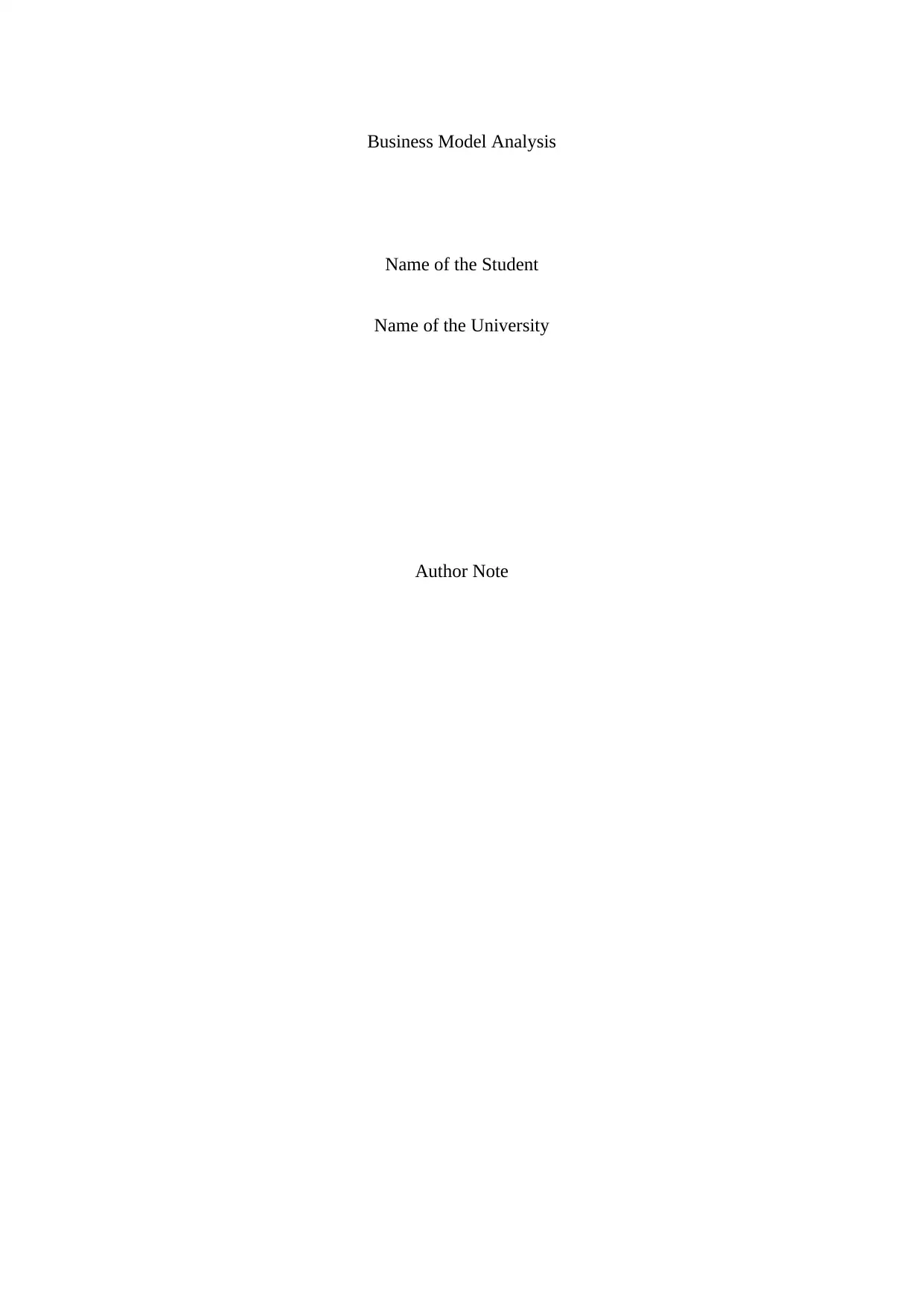
Business Model Analysis
Name of the Student
Name of the University
Author Note
Name of the Student
Name of the University
Author Note
Paraphrase This Document
Need a fresh take? Get an instant paraphrase of this document with our AI Paraphraser
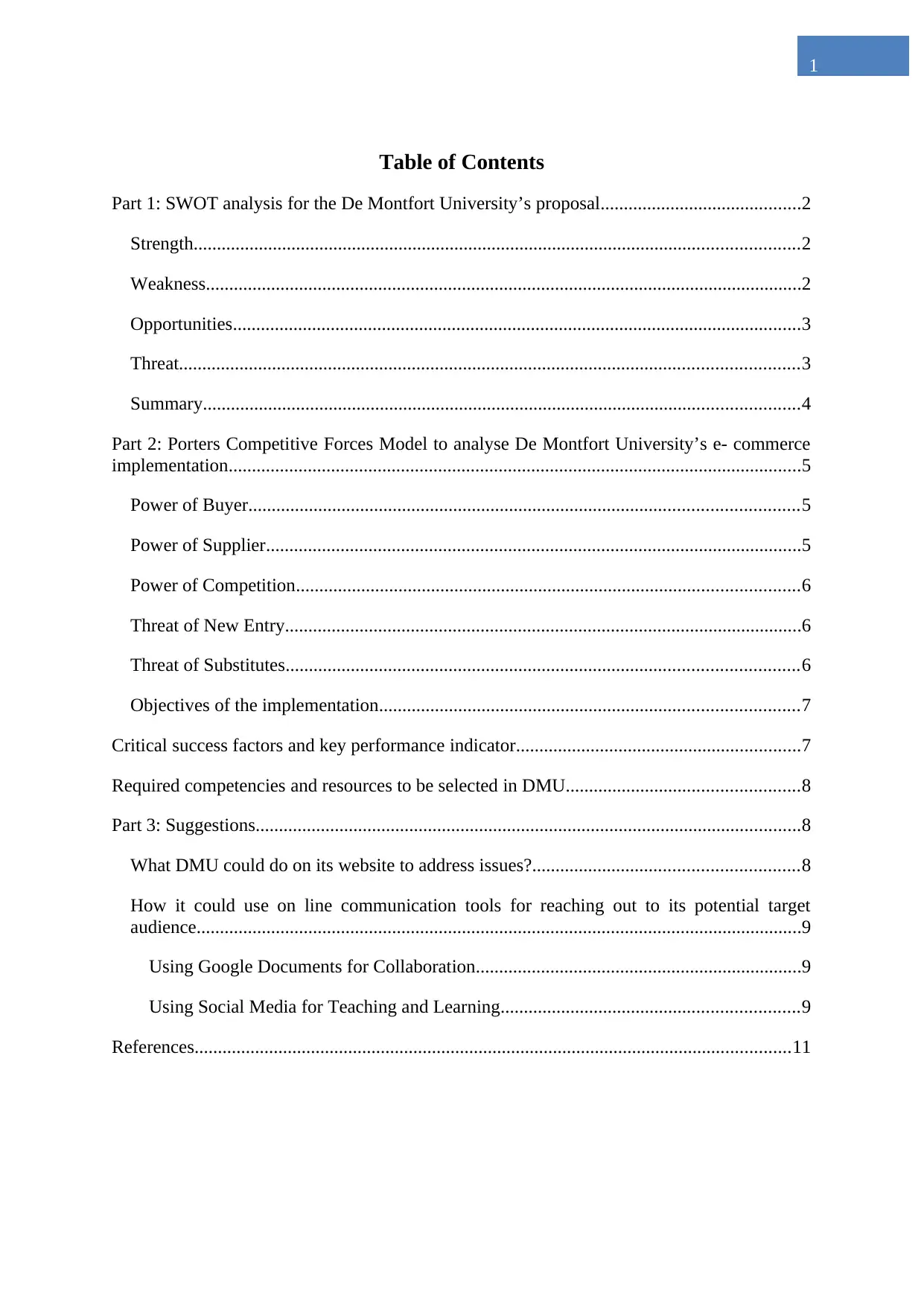
1
Table of Contents
Part 1: SWOT analysis for the De Montfort University’s proposal...........................................2
Strength..................................................................................................................................2
Weakness................................................................................................................................2
Opportunities..........................................................................................................................3
Threat.....................................................................................................................................3
Summary................................................................................................................................4
Part 2: Porters Competitive Forces Model to analyse De Montfort University’s e- commerce
implementation...........................................................................................................................5
Power of Buyer......................................................................................................................5
Power of Supplier...................................................................................................................5
Power of Competition............................................................................................................6
Threat of New Entry...............................................................................................................6
Threat of Substitutes..............................................................................................................6
Objectives of the implementation..........................................................................................7
Critical success factors and key performance indicator.............................................................7
Required competencies and resources to be selected in DMU..................................................8
Part 3: Suggestions.....................................................................................................................8
What DMU could do on its website to address issues?.........................................................8
How it could use on line communication tools for reaching out to its potential target
audience..................................................................................................................................9
Using Google Documents for Collaboration......................................................................9
Using Social Media for Teaching and Learning................................................................9
References................................................................................................................................11
Table of Contents
Part 1: SWOT analysis for the De Montfort University’s proposal...........................................2
Strength..................................................................................................................................2
Weakness................................................................................................................................2
Opportunities..........................................................................................................................3
Threat.....................................................................................................................................3
Summary................................................................................................................................4
Part 2: Porters Competitive Forces Model to analyse De Montfort University’s e- commerce
implementation...........................................................................................................................5
Power of Buyer......................................................................................................................5
Power of Supplier...................................................................................................................5
Power of Competition............................................................................................................6
Threat of New Entry...............................................................................................................6
Threat of Substitutes..............................................................................................................6
Objectives of the implementation..........................................................................................7
Critical success factors and key performance indicator.............................................................7
Required competencies and resources to be selected in DMU..................................................8
Part 3: Suggestions.....................................................................................................................8
What DMU could do on its website to address issues?.........................................................8
How it could use on line communication tools for reaching out to its potential target
audience..................................................................................................................................9
Using Google Documents for Collaboration......................................................................9
Using Social Media for Teaching and Learning................................................................9
References................................................................................................................................11
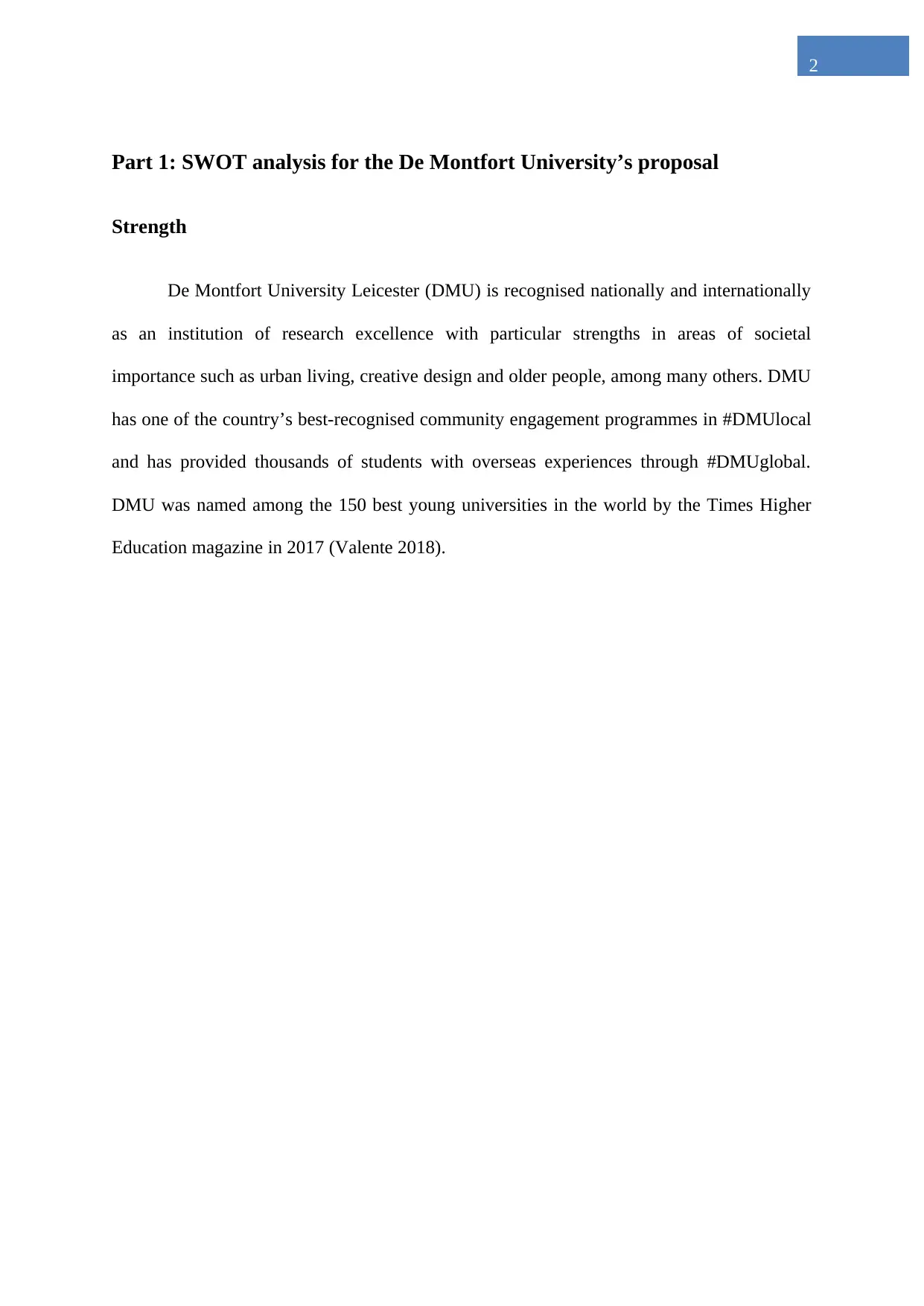
2
Part 1: SWOT analysis for the De Montfort University’s proposal
Strength
De Montfort University Leicester (DMU) is recognised nationally and internationally
as an institution of research excellence with particular strengths in areas of societal
importance such as urban living, creative design and older people, among many others. DMU
has one of the country’s best-recognised community engagement programmes in #DMUlocal
and has provided thousands of students with overseas experiences through #DMUglobal.
DMU was named among the 150 best young universities in the world by the Times Higher
Education magazine in 2017 (Valente 2018).
Part 1: SWOT analysis for the De Montfort University’s proposal
Strength
De Montfort University Leicester (DMU) is recognised nationally and internationally
as an institution of research excellence with particular strengths in areas of societal
importance such as urban living, creative design and older people, among many others. DMU
has one of the country’s best-recognised community engagement programmes in #DMUlocal
and has provided thousands of students with overseas experiences through #DMUglobal.
DMU was named among the 150 best young universities in the world by the Times Higher
Education magazine in 2017 (Valente 2018).
⊘ This is a preview!⊘
Do you want full access?
Subscribe today to unlock all pages.

Trusted by 1+ million students worldwide
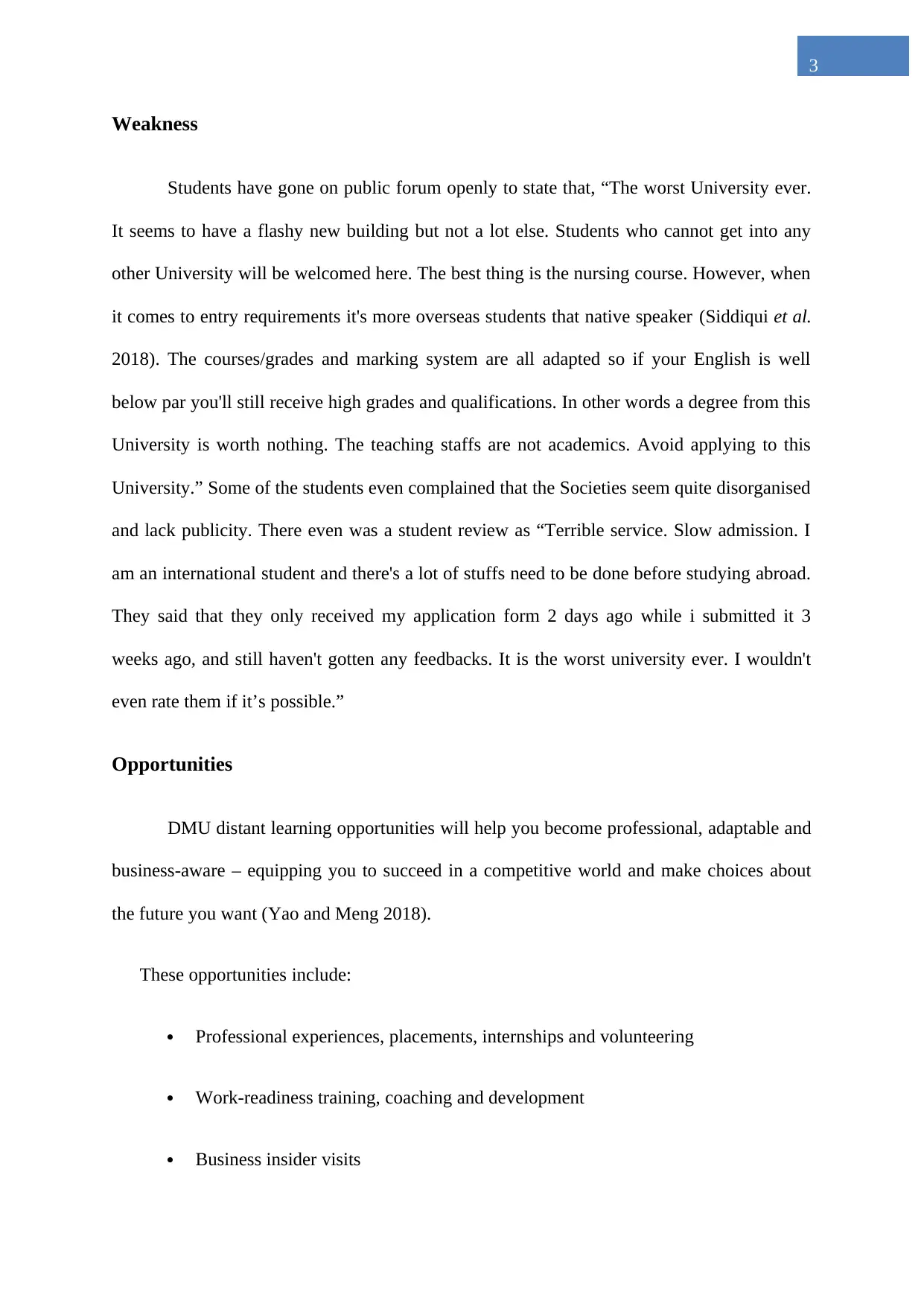
3
Weakness
Students have gone on public forum openly to state that, “The worst University ever.
It seems to have a flashy new building but not a lot else. Students who cannot get into any
other University will be welcomed here. The best thing is the nursing course. However, when
it comes to entry requirements it's more overseas students that native speaker (Siddiqui et al.
2018). The courses/grades and marking system are all adapted so if your English is well
below par you'll still receive high grades and qualifications. In other words a degree from this
University is worth nothing. The teaching staffs are not academics. Avoid applying to this
University.” Some of the students even complained that the Societies seem quite disorganised
and lack publicity. There even was a student review as “Terrible service. Slow admission. I
am an international student and there's a lot of stuffs need to be done before studying abroad.
They said that they only received my application form 2 days ago while i submitted it 3
weeks ago, and still haven't gotten any feedbacks. It is the worst university ever. I wouldn't
even rate them if it’s possible.”
Opportunities
DMU distant learning opportunities will help you become professional, adaptable and
business-aware – equipping you to succeed in a competitive world and make choices about
the future you want (Yao and Meng 2018).
These opportunities include:
Professional experiences, placements, internships and volunteering
Work-readiness training, coaching and development
Business insider visits
Weakness
Students have gone on public forum openly to state that, “The worst University ever.
It seems to have a flashy new building but not a lot else. Students who cannot get into any
other University will be welcomed here. The best thing is the nursing course. However, when
it comes to entry requirements it's more overseas students that native speaker (Siddiqui et al.
2018). The courses/grades and marking system are all adapted so if your English is well
below par you'll still receive high grades and qualifications. In other words a degree from this
University is worth nothing. The teaching staffs are not academics. Avoid applying to this
University.” Some of the students even complained that the Societies seem quite disorganised
and lack publicity. There even was a student review as “Terrible service. Slow admission. I
am an international student and there's a lot of stuffs need to be done before studying abroad.
They said that they only received my application form 2 days ago while i submitted it 3
weeks ago, and still haven't gotten any feedbacks. It is the worst university ever. I wouldn't
even rate them if it’s possible.”
Opportunities
DMU distant learning opportunities will help you become professional, adaptable and
business-aware – equipping you to succeed in a competitive world and make choices about
the future you want (Yao and Meng 2018).
These opportunities include:
Professional experiences, placements, internships and volunteering
Work-readiness training, coaching and development
Business insider visits
Paraphrase This Document
Need a fresh take? Get an instant paraphrase of this document with our AI Paraphraser
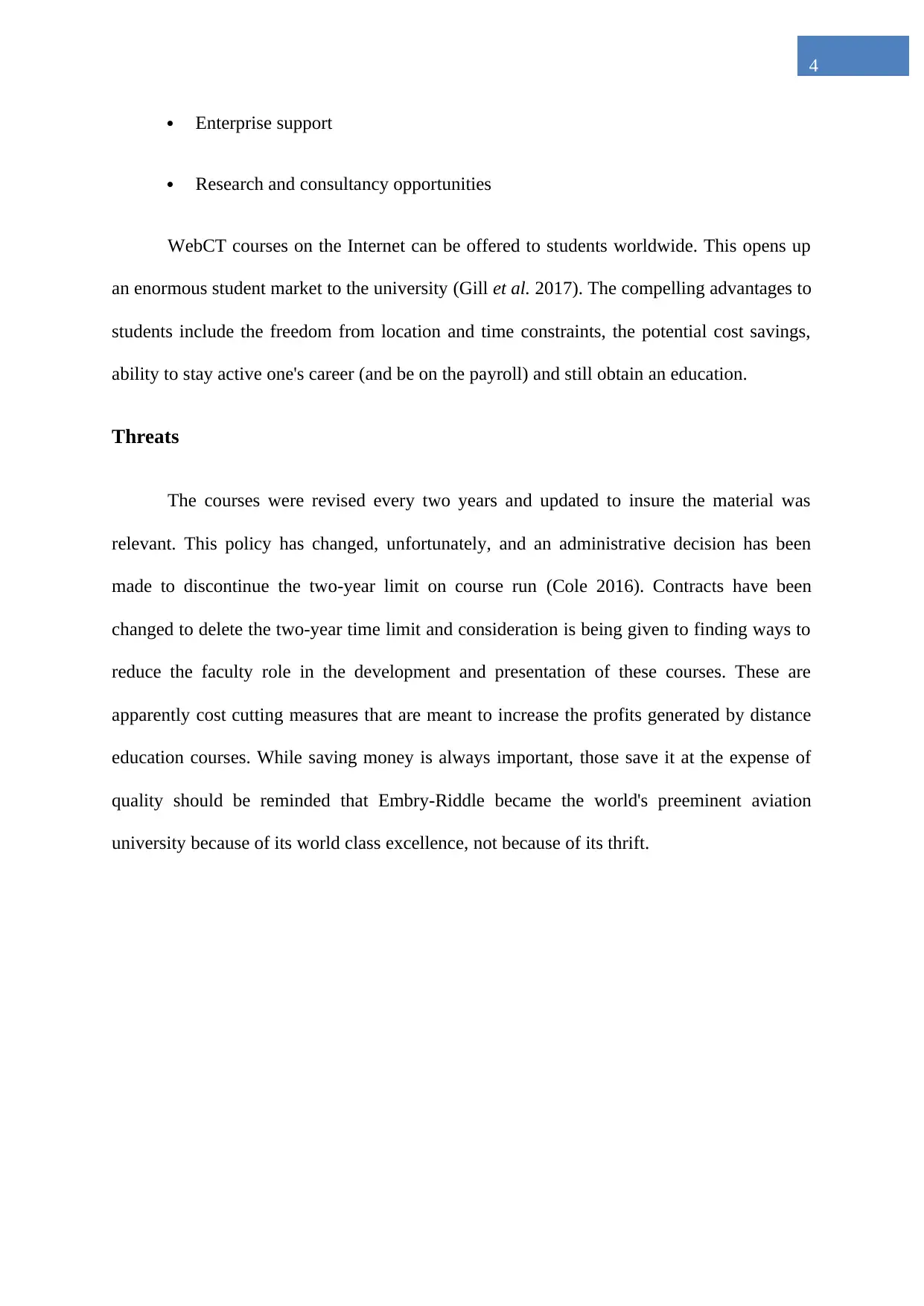
4
Enterprise support
Research and consultancy opportunities
WebCT courses on the Internet can be offered to students worldwide. This opens up
an enormous student market to the university (Gill et al. 2017). The compelling advantages to
students include the freedom from location and time constraints, the potential cost savings,
ability to stay active one's career (and be on the payroll) and still obtain an education.
Threats
The courses were revised every two years and updated to insure the material was
relevant. This policy has changed, unfortunately, and an administrative decision has been
made to discontinue the two-year limit on course run (Cole 2016). Contracts have been
changed to delete the two-year time limit and consideration is being given to finding ways to
reduce the faculty role in the development and presentation of these courses. These are
apparently cost cutting measures that are meant to increase the profits generated by distance
education courses. While saving money is always important, those save it at the expense of
quality should be reminded that Embry-Riddle became the world's preeminent aviation
university because of its world class excellence, not because of its thrift.
Enterprise support
Research and consultancy opportunities
WebCT courses on the Internet can be offered to students worldwide. This opens up
an enormous student market to the university (Gill et al. 2017). The compelling advantages to
students include the freedom from location and time constraints, the potential cost savings,
ability to stay active one's career (and be on the payroll) and still obtain an education.
Threats
The courses were revised every two years and updated to insure the material was
relevant. This policy has changed, unfortunately, and an administrative decision has been
made to discontinue the two-year limit on course run (Cole 2016). Contracts have been
changed to delete the two-year time limit and consideration is being given to finding ways to
reduce the faculty role in the development and presentation of these courses. These are
apparently cost cutting measures that are meant to increase the profits generated by distance
education courses. While saving money is always important, those save it at the expense of
quality should be reminded that Embry-Riddle became the world's preeminent aviation
university because of its world class excellence, not because of its thrift.
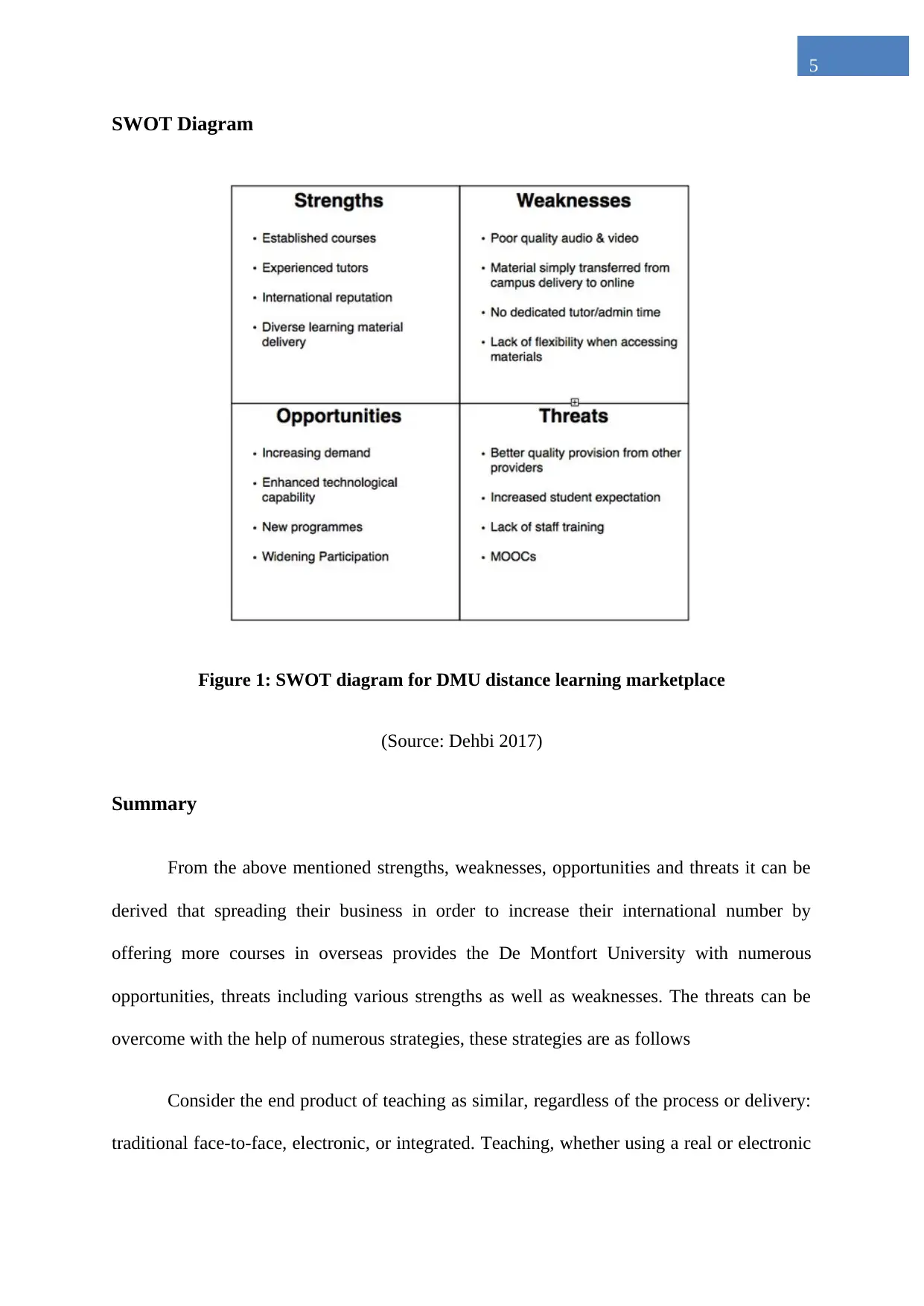
5
SWOT Diagram
Figure 1: SWOT diagram for DMU distance learning marketplace
(Source: Dehbi 2017)
Summary
From the above mentioned strengths, weaknesses, opportunities and threats it can be
derived that spreading their business in order to increase their international number by
offering more courses in overseas provides the De Montfort University with numerous
opportunities, threats including various strengths as well as weaknesses. The threats can be
overcome with the help of numerous strategies, these strategies are as follows
Consider the end product of teaching as similar, regardless of the process or delivery:
traditional face-to-face, electronic, or integrated. Teaching, whether using a real or electronic
SWOT Diagram
Figure 1: SWOT diagram for DMU distance learning marketplace
(Source: Dehbi 2017)
Summary
From the above mentioned strengths, weaknesses, opportunities and threats it can be
derived that spreading their business in order to increase their international number by
offering more courses in overseas provides the De Montfort University with numerous
opportunities, threats including various strengths as well as weaknesses. The threats can be
overcome with the help of numerous strategies, these strategies are as follows
Consider the end product of teaching as similar, regardless of the process or delivery:
traditional face-to-face, electronic, or integrated. Teaching, whether using a real or electronic
⊘ This is a preview!⊘
Do you want full access?
Subscribe today to unlock all pages.

Trusted by 1+ million students worldwide
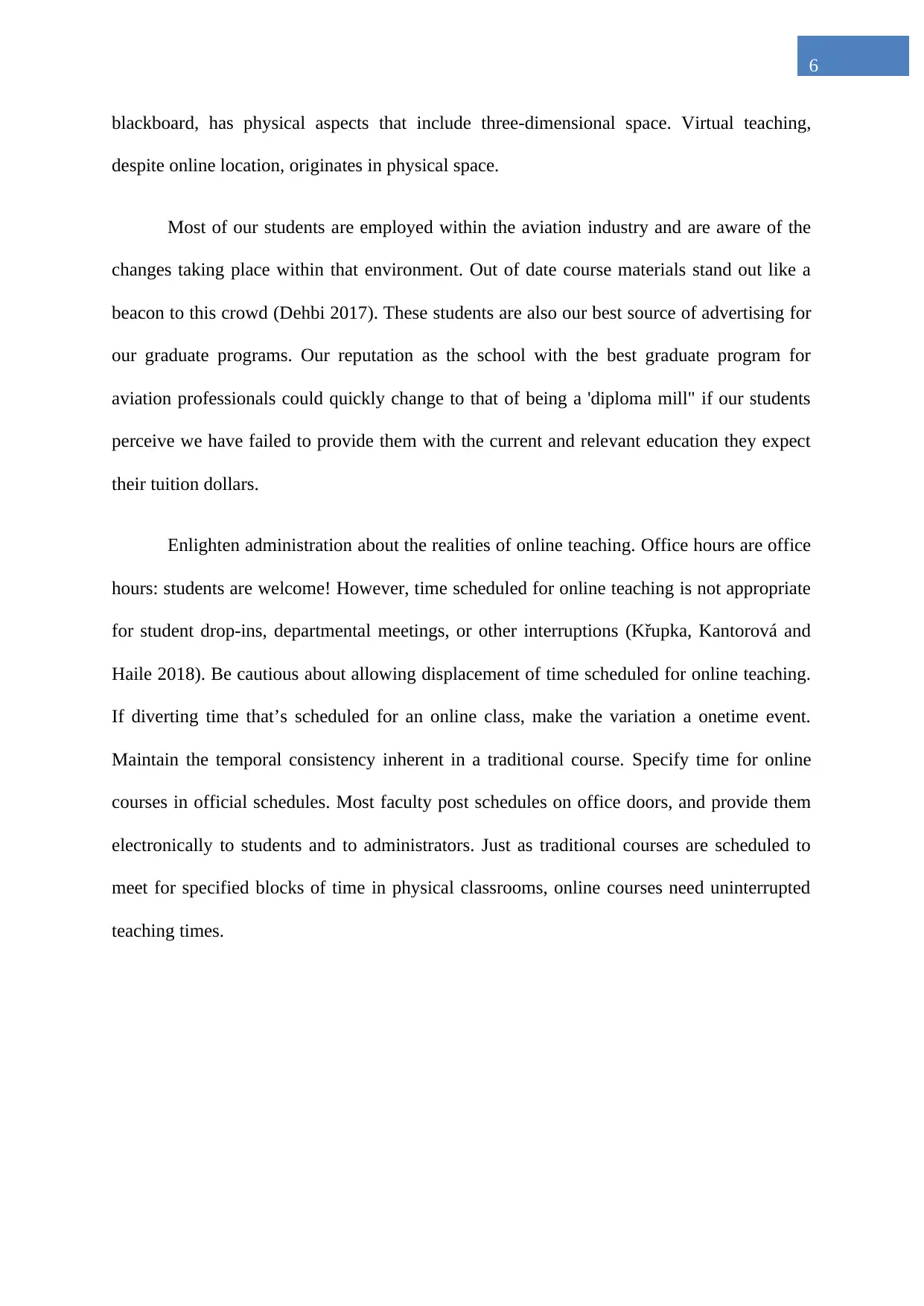
6
blackboard, has physical aspects that include three-dimensional space. Virtual teaching,
despite online location, originates in physical space.
Most of our students are employed within the aviation industry and are aware of the
changes taking place within that environment. Out of date course materials stand out like a
beacon to this crowd (Dehbi 2017). These students are also our best source of advertising for
our graduate programs. Our reputation as the school with the best graduate program for
aviation professionals could quickly change to that of being a 'diploma mill" if our students
perceive we have failed to provide them with the current and relevant education they expect
their tuition dollars.
Enlighten administration about the realities of online teaching. Office hours are office
hours: students are welcome! However, time scheduled for online teaching is not appropriate
for student drop-ins, departmental meetings, or other interruptions (Křupka, Kantorová and
Haile 2018). Be cautious about allowing displacement of time scheduled for online teaching.
If diverting time that’s scheduled for an online class, make the variation a onetime event.
Maintain the temporal consistency inherent in a traditional course. Specify time for online
courses in official schedules. Most faculty post schedules on office doors, and provide them
electronically to students and to administrators. Just as traditional courses are scheduled to
meet for specified blocks of time in physical classrooms, online courses need uninterrupted
teaching times.
blackboard, has physical aspects that include three-dimensional space. Virtual teaching,
despite online location, originates in physical space.
Most of our students are employed within the aviation industry and are aware of the
changes taking place within that environment. Out of date course materials stand out like a
beacon to this crowd (Dehbi 2017). These students are also our best source of advertising for
our graduate programs. Our reputation as the school with the best graduate program for
aviation professionals could quickly change to that of being a 'diploma mill" if our students
perceive we have failed to provide them with the current and relevant education they expect
their tuition dollars.
Enlighten administration about the realities of online teaching. Office hours are office
hours: students are welcome! However, time scheduled for online teaching is not appropriate
for student drop-ins, departmental meetings, or other interruptions (Křupka, Kantorová and
Haile 2018). Be cautious about allowing displacement of time scheduled for online teaching.
If diverting time that’s scheduled for an online class, make the variation a onetime event.
Maintain the temporal consistency inherent in a traditional course. Specify time for online
courses in official schedules. Most faculty post schedules on office doors, and provide them
electronically to students and to administrators. Just as traditional courses are scheduled to
meet for specified blocks of time in physical classrooms, online courses need uninterrupted
teaching times.
Paraphrase This Document
Need a fresh take? Get an instant paraphrase of this document with our AI Paraphraser
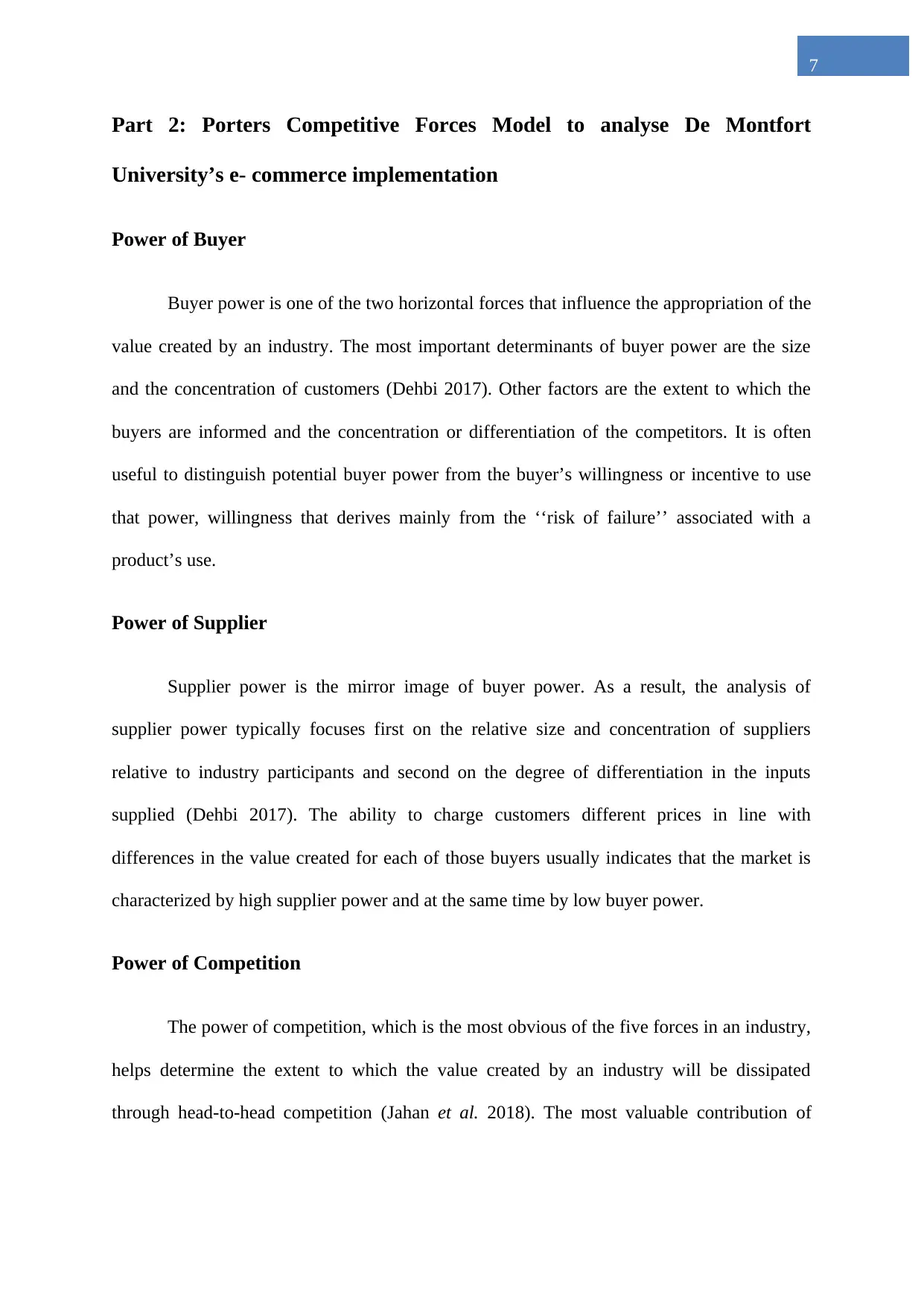
7
Part 2: Porters Competitive Forces Model to analyse De Montfort
University’s e- commerce implementation
Power of Buyer
Buyer power is one of the two horizontal forces that influence the appropriation of the
value created by an industry. The most important determinants of buyer power are the size
and the concentration of customers (Dehbi 2017). Other factors are the extent to which the
buyers are informed and the concentration or differentiation of the competitors. It is often
useful to distinguish potential buyer power from the buyer’s willingness or incentive to use
that power, willingness that derives mainly from the ‘‘risk of failure’’ associated with a
product’s use.
Power of Supplier
Supplier power is the mirror image of buyer power. As a result, the analysis of
supplier power typically focuses first on the relative size and concentration of suppliers
relative to industry participants and second on the degree of differentiation in the inputs
supplied (Dehbi 2017). The ability to charge customers different prices in line with
differences in the value created for each of those buyers usually indicates that the market is
characterized by high supplier power and at the same time by low buyer power.
Power of Competition
The power of competition, which is the most obvious of the five forces in an industry,
helps determine the extent to which the value created by an industry will be dissipated
through head-to-head competition (Jahan et al. 2018). The most valuable contribution of
Part 2: Porters Competitive Forces Model to analyse De Montfort
University’s e- commerce implementation
Power of Buyer
Buyer power is one of the two horizontal forces that influence the appropriation of the
value created by an industry. The most important determinants of buyer power are the size
and the concentration of customers (Dehbi 2017). Other factors are the extent to which the
buyers are informed and the concentration or differentiation of the competitors. It is often
useful to distinguish potential buyer power from the buyer’s willingness or incentive to use
that power, willingness that derives mainly from the ‘‘risk of failure’’ associated with a
product’s use.
Power of Supplier
Supplier power is the mirror image of buyer power. As a result, the analysis of
supplier power typically focuses first on the relative size and concentration of suppliers
relative to industry participants and second on the degree of differentiation in the inputs
supplied (Dehbi 2017). The ability to charge customers different prices in line with
differences in the value created for each of those buyers usually indicates that the market is
characterized by high supplier power and at the same time by low buyer power.
Power of Competition
The power of competition, which is the most obvious of the five forces in an industry,
helps determine the extent to which the value created by an industry will be dissipated
through head-to-head competition (Jahan et al. 2018). The most valuable contribution of
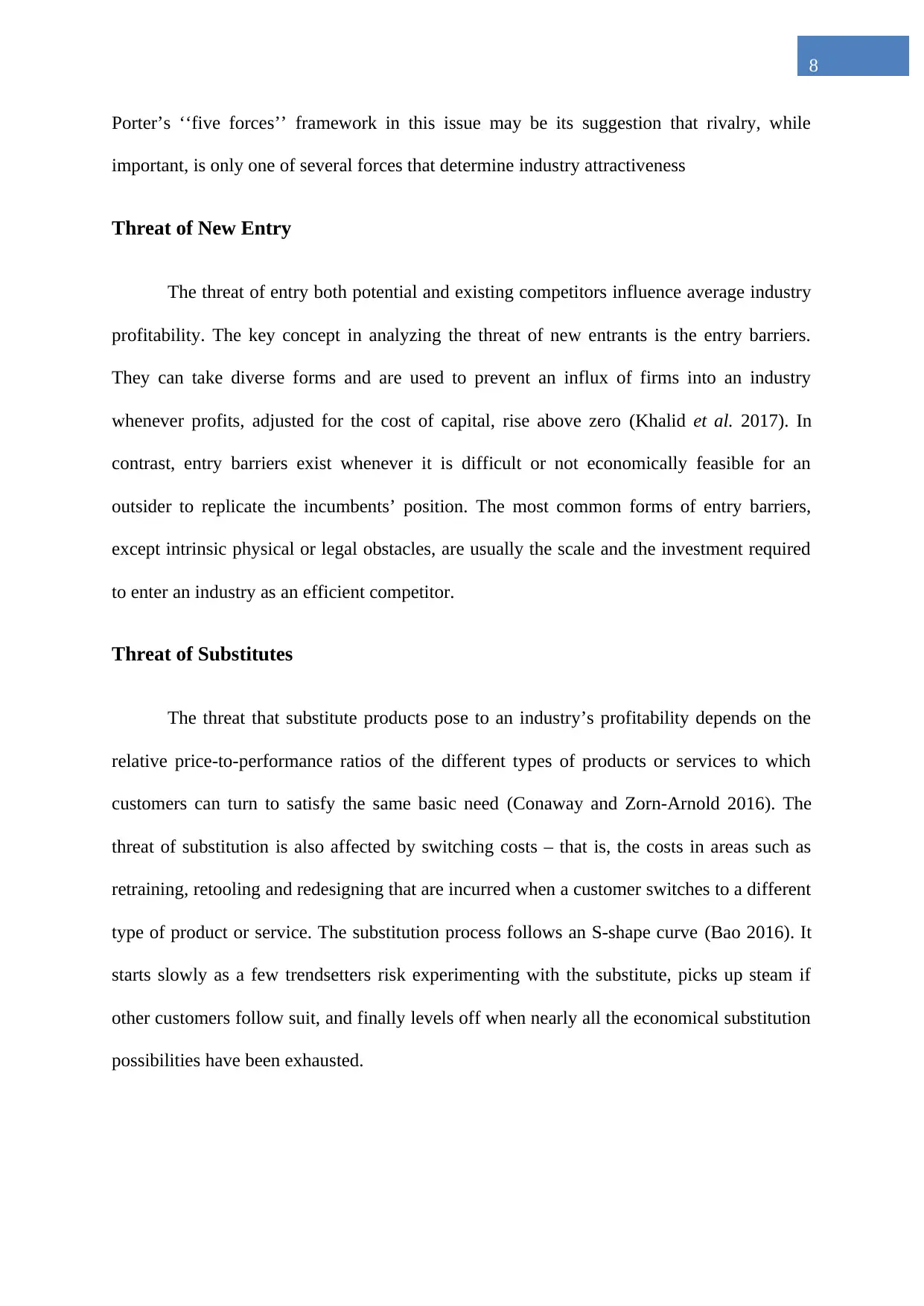
8
Porter’s ‘‘five forces’’ framework in this issue may be its suggestion that rivalry, while
important, is only one of several forces that determine industry attractiveness
Threat of New Entry
The threat of entry both potential and existing competitors influence average industry
profitability. The key concept in analyzing the threat of new entrants is the entry barriers.
They can take diverse forms and are used to prevent an influx of firms into an industry
whenever profits, adjusted for the cost of capital, rise above zero (Khalid et al. 2017). In
contrast, entry barriers exist whenever it is difficult or not economically feasible for an
outsider to replicate the incumbents’ position. The most common forms of entry barriers,
except intrinsic physical or legal obstacles, are usually the scale and the investment required
to enter an industry as an efficient competitor.
Threat of Substitutes
The threat that substitute products pose to an industry’s profitability depends on the
relative price-to-performance ratios of the different types of products or services to which
customers can turn to satisfy the same basic need (Conaway and Zorn-Arnold 2016). The
threat of substitution is also affected by switching costs – that is, the costs in areas such as
retraining, retooling and redesigning that are incurred when a customer switches to a different
type of product or service. The substitution process follows an S-shape curve (Bao 2016). It
starts slowly as a few trendsetters risk experimenting with the substitute, picks up steam if
other customers follow suit, and finally levels off when nearly all the economical substitution
possibilities have been exhausted.
Porter’s ‘‘five forces’’ framework in this issue may be its suggestion that rivalry, while
important, is only one of several forces that determine industry attractiveness
Threat of New Entry
The threat of entry both potential and existing competitors influence average industry
profitability. The key concept in analyzing the threat of new entrants is the entry barriers.
They can take diverse forms and are used to prevent an influx of firms into an industry
whenever profits, adjusted for the cost of capital, rise above zero (Khalid et al. 2017). In
contrast, entry barriers exist whenever it is difficult or not economically feasible for an
outsider to replicate the incumbents’ position. The most common forms of entry barriers,
except intrinsic physical or legal obstacles, are usually the scale and the investment required
to enter an industry as an efficient competitor.
Threat of Substitutes
The threat that substitute products pose to an industry’s profitability depends on the
relative price-to-performance ratios of the different types of products or services to which
customers can turn to satisfy the same basic need (Conaway and Zorn-Arnold 2016). The
threat of substitution is also affected by switching costs – that is, the costs in areas such as
retraining, retooling and redesigning that are incurred when a customer switches to a different
type of product or service. The substitution process follows an S-shape curve (Bao 2016). It
starts slowly as a few trendsetters risk experimenting with the substitute, picks up steam if
other customers follow suit, and finally levels off when nearly all the economical substitution
possibilities have been exhausted.
⊘ This is a preview!⊘
Do you want full access?
Subscribe today to unlock all pages.

Trusted by 1+ million students worldwide
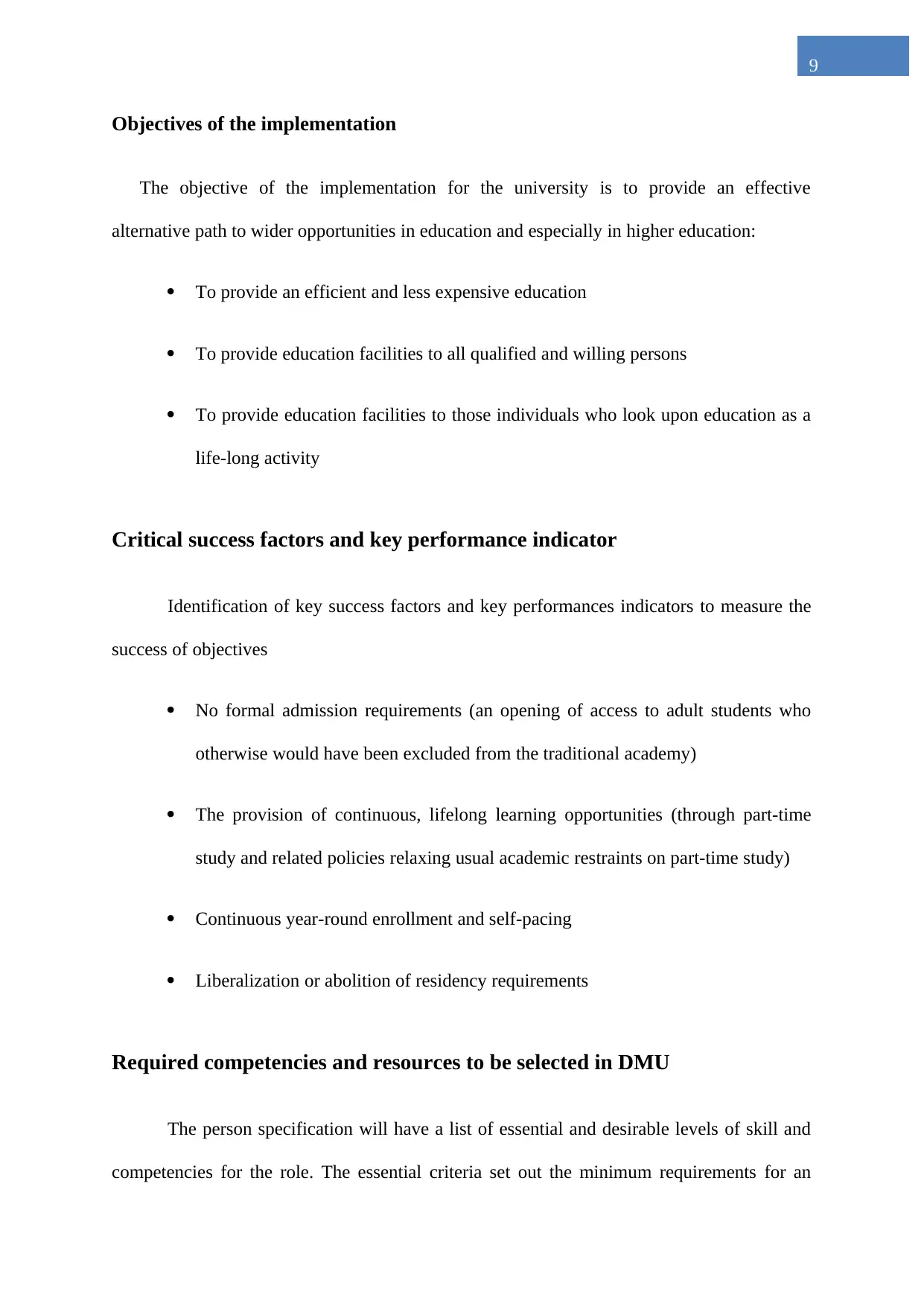
9
Objectives of the implementation
The objective of the implementation for the university is to provide an effective
alternative path to wider opportunities in education and especially in higher education:
To provide an efficient and less expensive education
To provide education facilities to all qualified and willing persons
To provide education facilities to those individuals who look upon education as a
life-long activity
Critical success factors and key performance indicator
Identification of key success factors and key performances indicators to measure the
success of objectives
No formal admission requirements (an opening of access to adult students who
otherwise would have been excluded from the traditional academy)
The provision of continuous, lifelong learning opportunities (through part-time
study and related policies relaxing usual academic restraints on part-time study)
Continuous year-round enrollment and self-pacing
Liberalization or abolition of residency requirements
Required competencies and resources to be selected in DMU
The person specification will have a list of essential and desirable levels of skill and
competencies for the role. The essential criteria set out the minimum requirements for an
Objectives of the implementation
The objective of the implementation for the university is to provide an effective
alternative path to wider opportunities in education and especially in higher education:
To provide an efficient and less expensive education
To provide education facilities to all qualified and willing persons
To provide education facilities to those individuals who look upon education as a
life-long activity
Critical success factors and key performance indicator
Identification of key success factors and key performances indicators to measure the
success of objectives
No formal admission requirements (an opening of access to adult students who
otherwise would have been excluded from the traditional academy)
The provision of continuous, lifelong learning opportunities (through part-time
study and related policies relaxing usual academic restraints on part-time study)
Continuous year-round enrollment and self-pacing
Liberalization or abolition of residency requirements
Required competencies and resources to be selected in DMU
The person specification will have a list of essential and desirable levels of skill and
competencies for the role. The essential criteria set out the minimum requirements for an
Paraphrase This Document
Need a fresh take? Get an instant paraphrase of this document with our AI Paraphraser
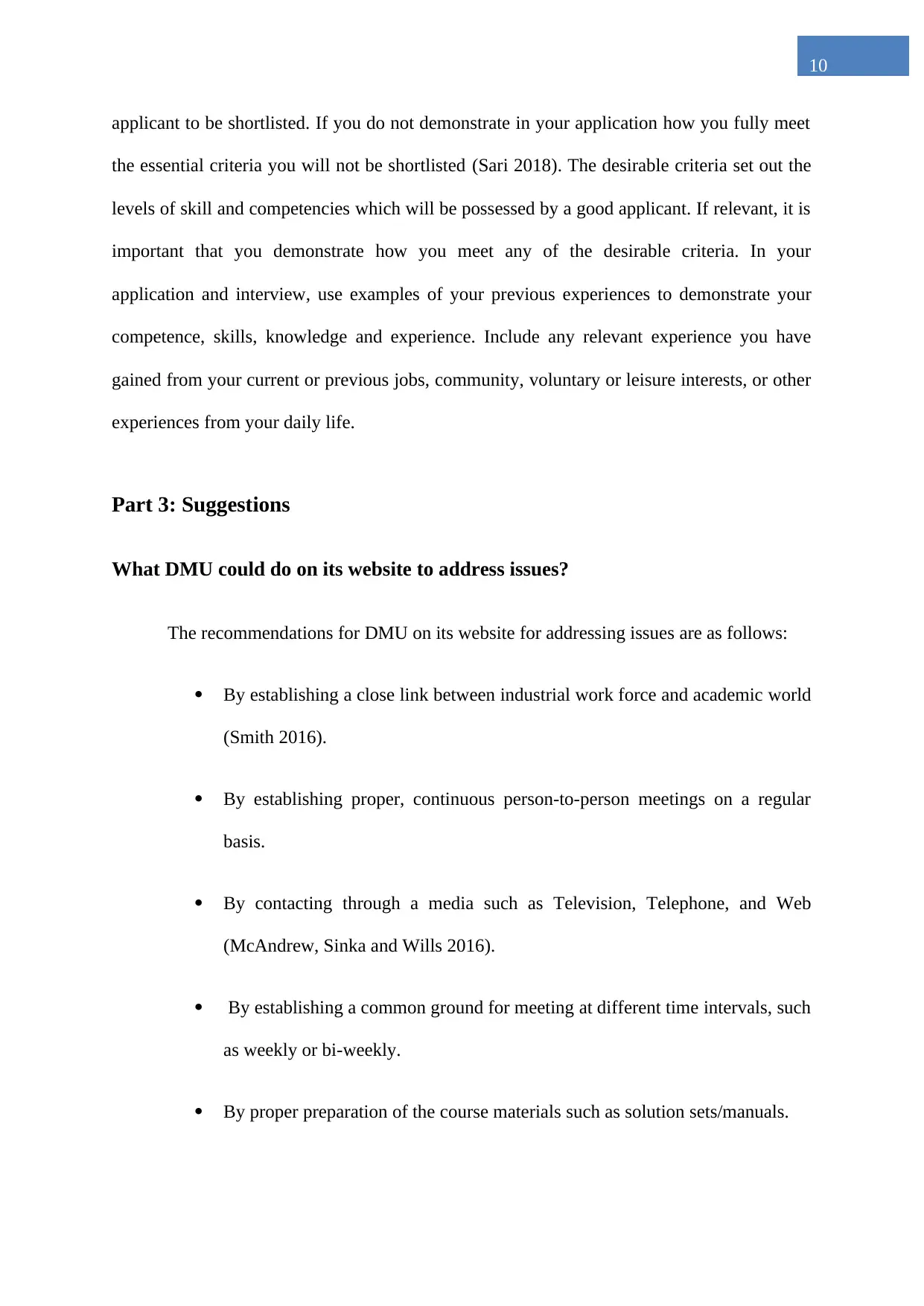
10
applicant to be shortlisted. If you do not demonstrate in your application how you fully meet
the essential criteria you will not be shortlisted (Sari 2018). The desirable criteria set out the
levels of skill and competencies which will be possessed by a good applicant. If relevant, it is
important that you demonstrate how you meet any of the desirable criteria. In your
application and interview, use examples of your previous experiences to demonstrate your
competence, skills, knowledge and experience. Include any relevant experience you have
gained from your current or previous jobs, community, voluntary or leisure interests, or other
experiences from your daily life.
Part 3: Suggestions
What DMU could do on its website to address issues?
The recommendations for DMU on its website for addressing issues are as follows:
By establishing a close link between industrial work force and academic world
(Smith 2016).
By establishing proper, continuous person-to-person meetings on a regular
basis.
By contacting through a media such as Television, Telephone, and Web
(McAndrew, Sinka and Wills 2016).
By establishing a common ground for meeting at different time intervals, such
as weekly or bi-weekly.
By proper preparation of the course materials such as solution sets/manuals.
applicant to be shortlisted. If you do not demonstrate in your application how you fully meet
the essential criteria you will not be shortlisted (Sari 2018). The desirable criteria set out the
levels of skill and competencies which will be possessed by a good applicant. If relevant, it is
important that you demonstrate how you meet any of the desirable criteria. In your
application and interview, use examples of your previous experiences to demonstrate your
competence, skills, knowledge and experience. Include any relevant experience you have
gained from your current or previous jobs, community, voluntary or leisure interests, or other
experiences from your daily life.
Part 3: Suggestions
What DMU could do on its website to address issues?
The recommendations for DMU on its website for addressing issues are as follows:
By establishing a close link between industrial work force and academic world
(Smith 2016).
By establishing proper, continuous person-to-person meetings on a regular
basis.
By contacting through a media such as Television, Telephone, and Web
(McAndrew, Sinka and Wills 2016).
By establishing a common ground for meeting at different time intervals, such
as weekly or bi-weekly.
By proper preparation of the course materials such as solution sets/manuals.
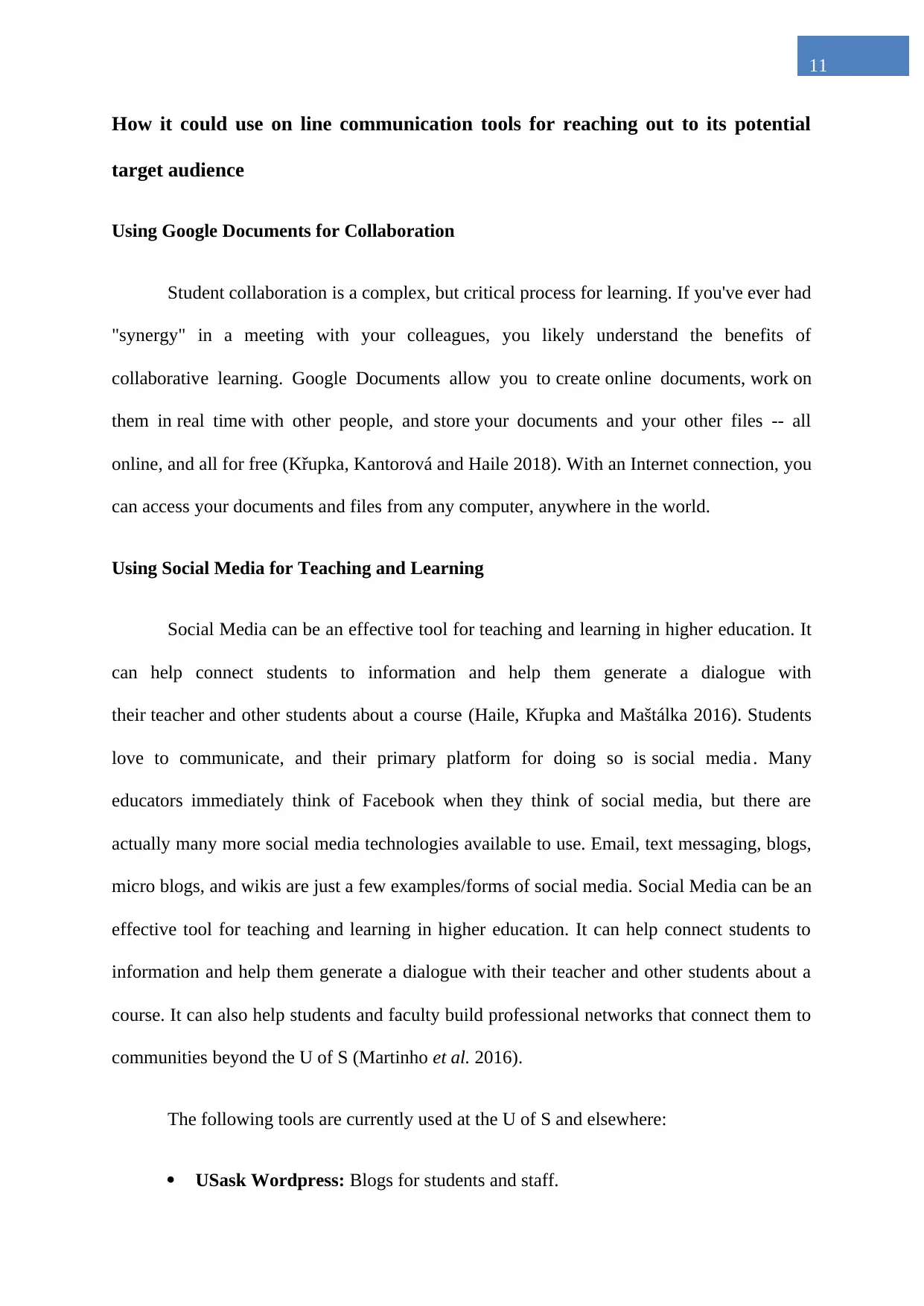
11
How it could use on line communication tools for reaching out to its potential
target audience
Using Google Documents for Collaboration
Student collaboration is a complex, but critical process for learning. If you've ever had
"synergy" in a meeting with your colleagues, you likely understand the benefits of
collaborative learning. Google Documents allow you to create online documents, work on
them in real time with other people, and store your documents and your other files -- all
online, and all for free (Křupka, Kantorová and Haile 2018). With an Internet connection, you
can access your documents and files from any computer, anywhere in the world.
Using Social Media for Teaching and Learning
Social Media can be an effective tool for teaching and learning in higher education. It
can help connect students to information and help them generate a dialogue with
their teacher and other students about a course (Haile, Křupka and Maštálka 2016). Students
love to communicate, and their primary platform for doing so is social media . Many
educators immediately think of Facebook when they think of social media, but there are
actually many more social media technologies available to use. Email, text messaging, blogs,
micro blogs, and wikis are just a few examples/forms of social media. Social Media can be an
effective tool for teaching and learning in higher education. It can help connect students to
information and help them generate a dialogue with their teacher and other students about a
course. It can also help students and faculty build professional networks that connect them to
communities beyond the U of S (Martinho et al. 2016).
The following tools are currently used at the U of S and elsewhere:
USask Wordpress: Blogs for students and staff.
How it could use on line communication tools for reaching out to its potential
target audience
Using Google Documents for Collaboration
Student collaboration is a complex, but critical process for learning. If you've ever had
"synergy" in a meeting with your colleagues, you likely understand the benefits of
collaborative learning. Google Documents allow you to create online documents, work on
them in real time with other people, and store your documents and your other files -- all
online, and all for free (Křupka, Kantorová and Haile 2018). With an Internet connection, you
can access your documents and files from any computer, anywhere in the world.
Using Social Media for Teaching and Learning
Social Media can be an effective tool for teaching and learning in higher education. It
can help connect students to information and help them generate a dialogue with
their teacher and other students about a course (Haile, Křupka and Maštálka 2016). Students
love to communicate, and their primary platform for doing so is social media . Many
educators immediately think of Facebook when they think of social media, but there are
actually many more social media technologies available to use. Email, text messaging, blogs,
micro blogs, and wikis are just a few examples/forms of social media. Social Media can be an
effective tool for teaching and learning in higher education. It can help connect students to
information and help them generate a dialogue with their teacher and other students about a
course. It can also help students and faculty build professional networks that connect them to
communities beyond the U of S (Martinho et al. 2016).
The following tools are currently used at the U of S and elsewhere:
USask Wordpress: Blogs for students and staff.
⊘ This is a preview!⊘
Do you want full access?
Subscribe today to unlock all pages.

Trusted by 1+ million students worldwide
1 out of 16
Related Documents
Your All-in-One AI-Powered Toolkit for Academic Success.
+13062052269
info@desklib.com
Available 24*7 on WhatsApp / Email
![[object Object]](/_next/static/media/star-bottom.7253800d.svg)
Unlock your academic potential
Copyright © 2020–2025 A2Z Services. All Rights Reserved. Developed and managed by ZUCOL.



